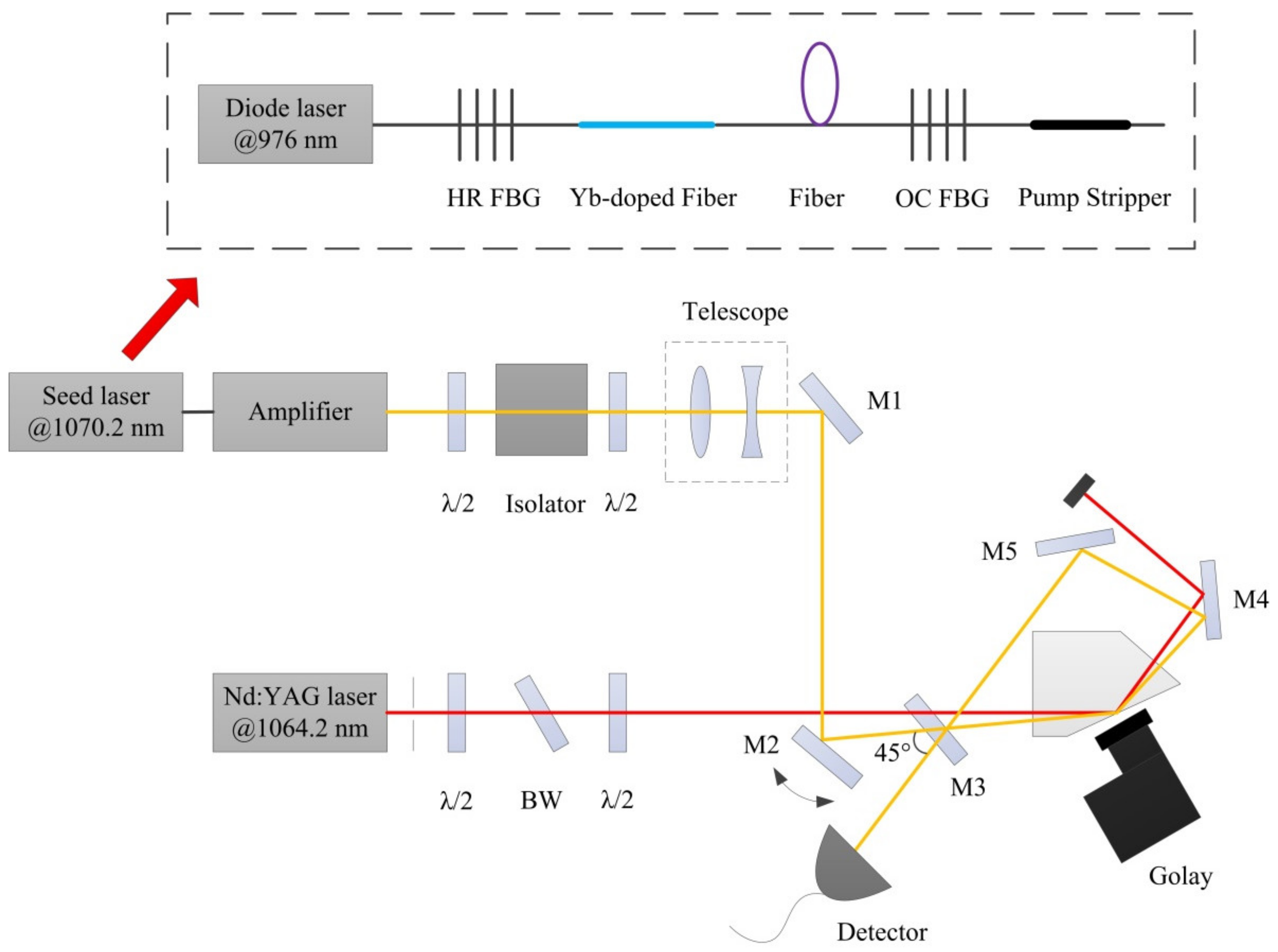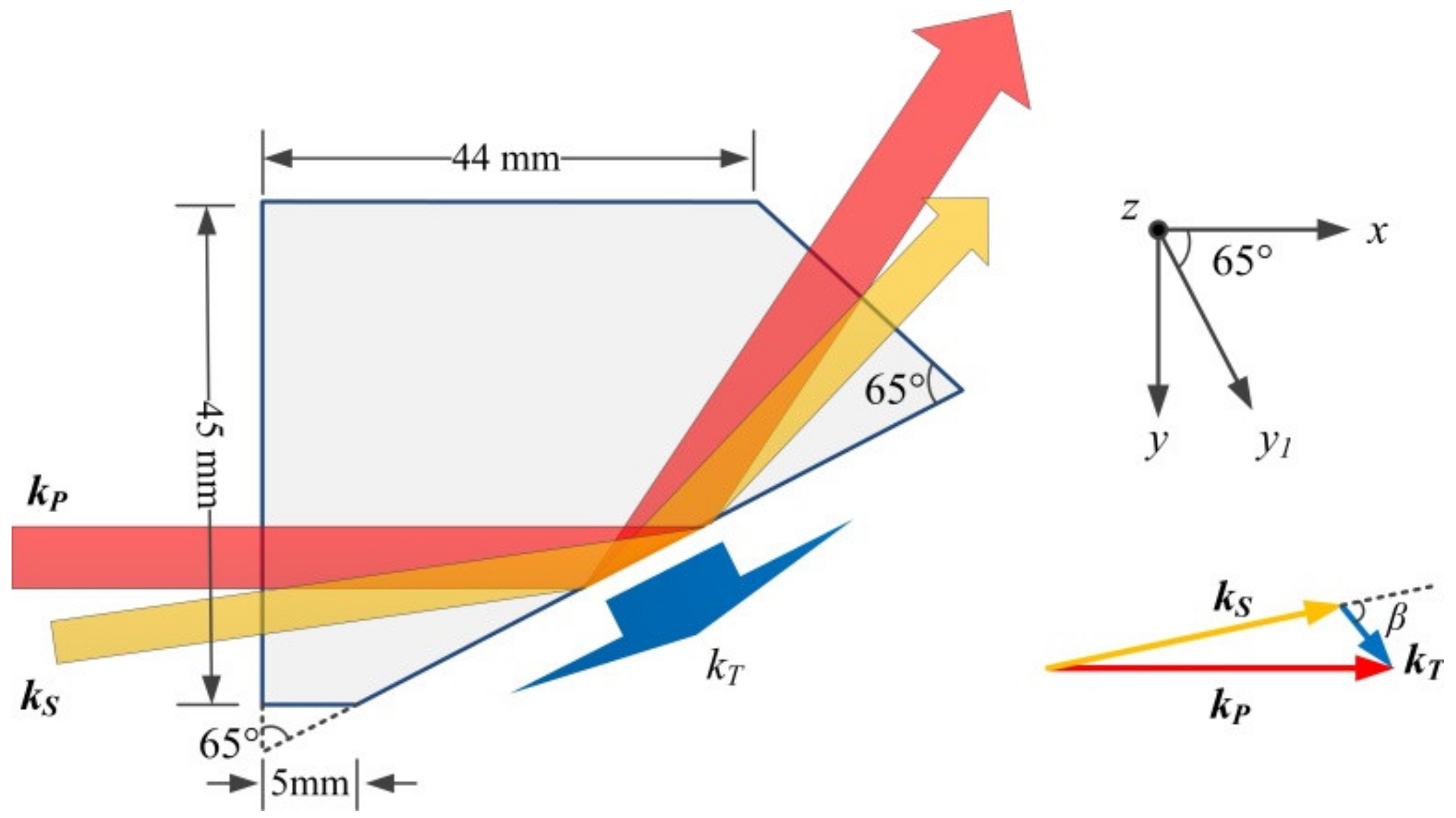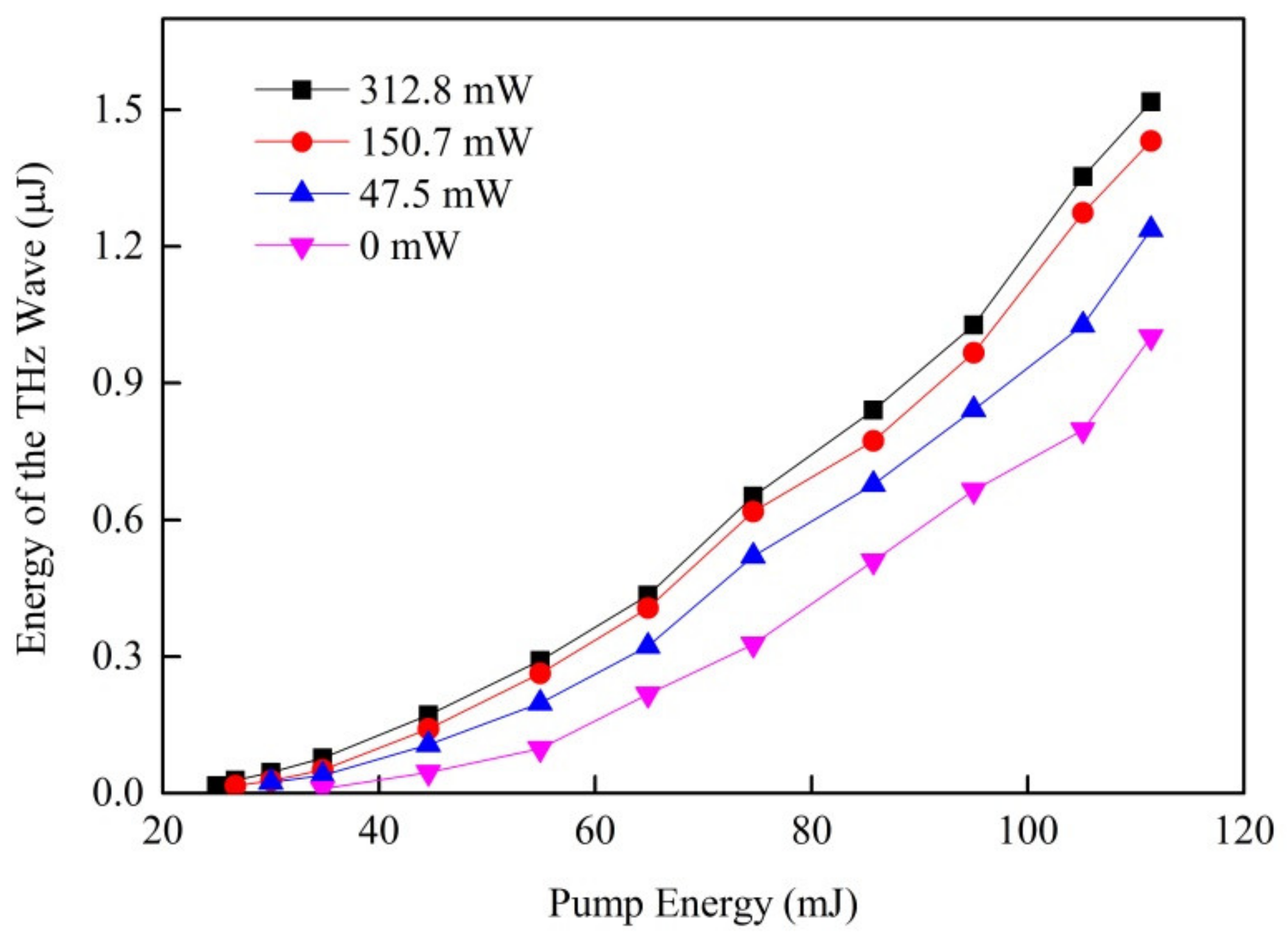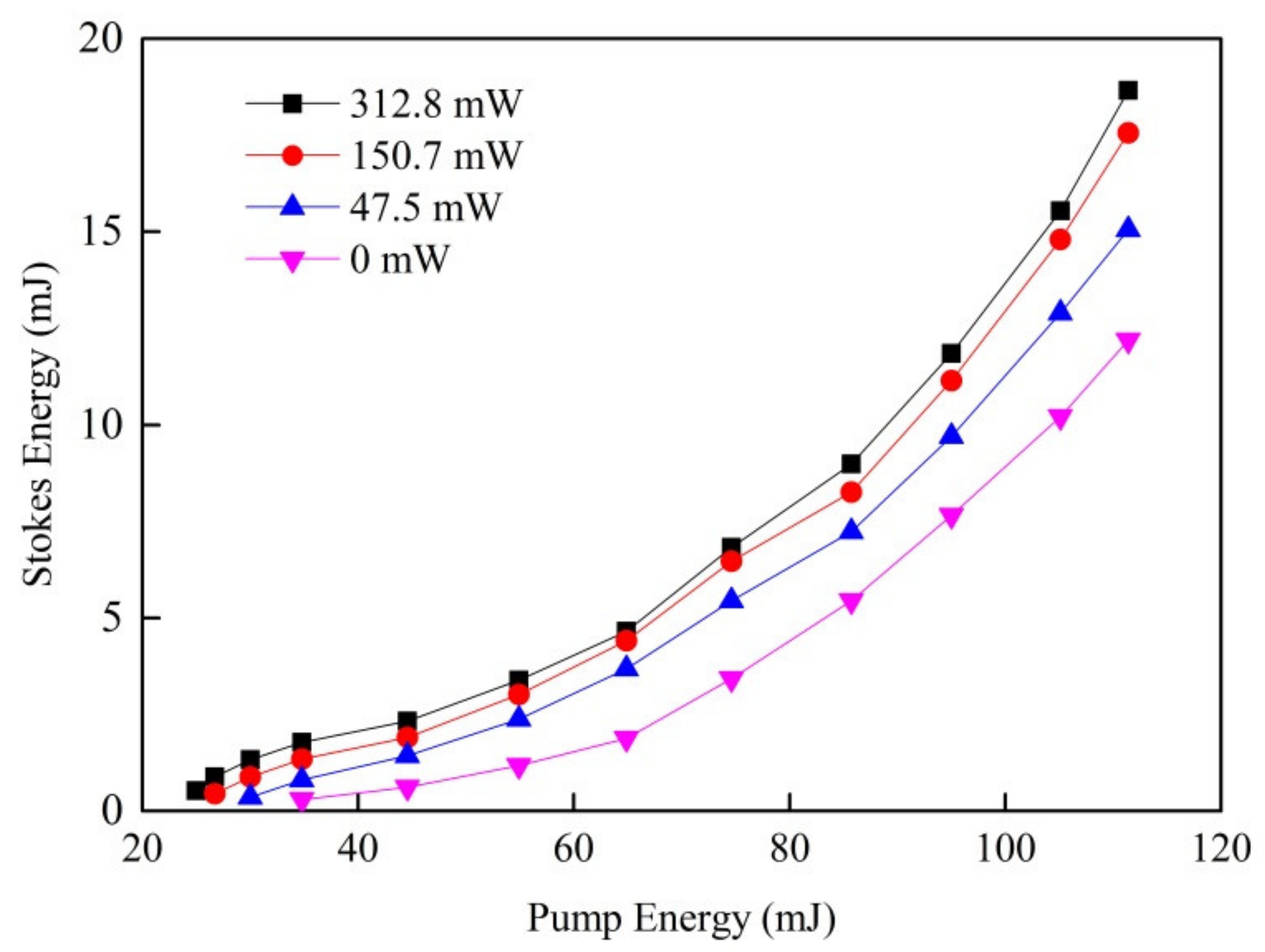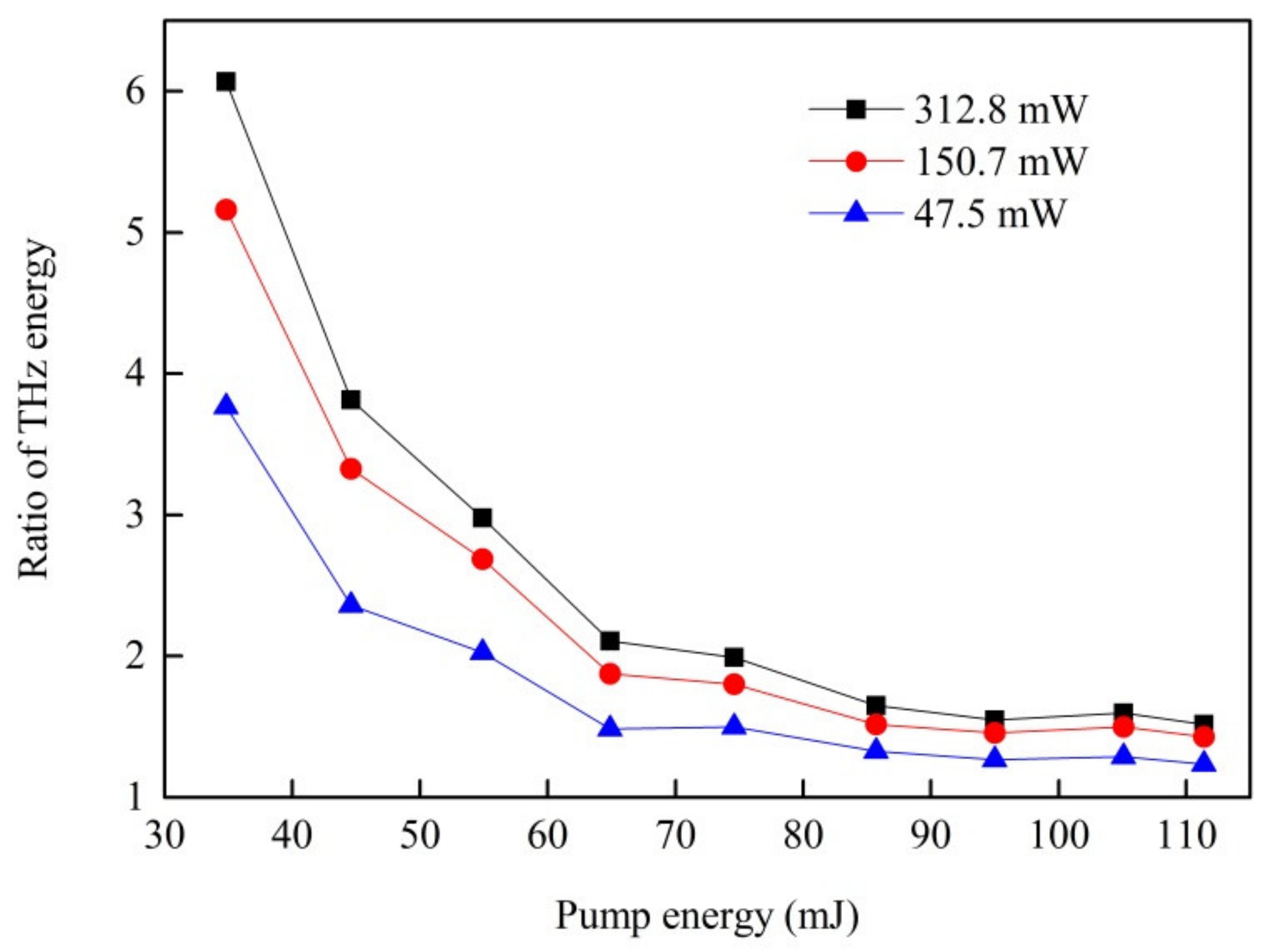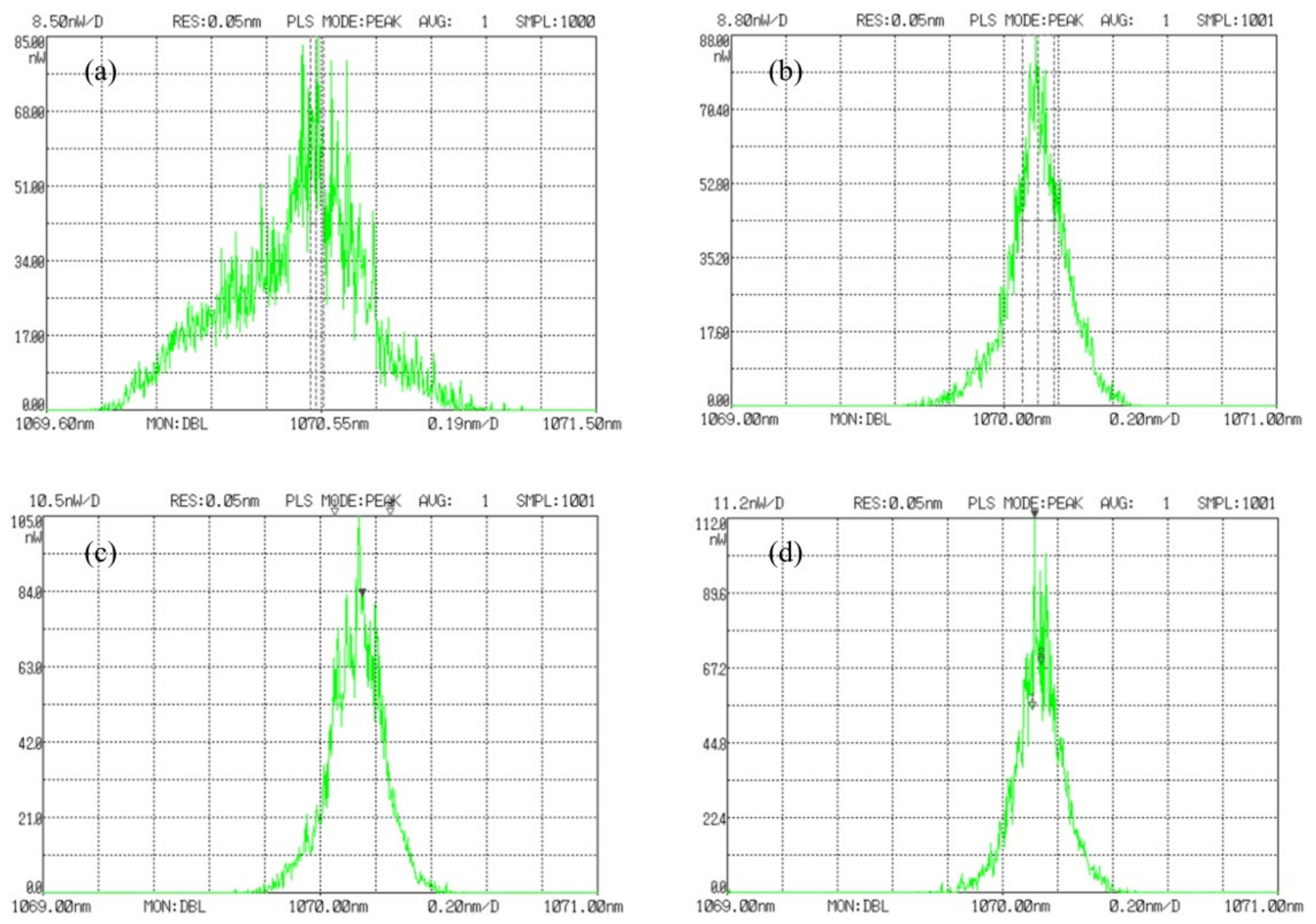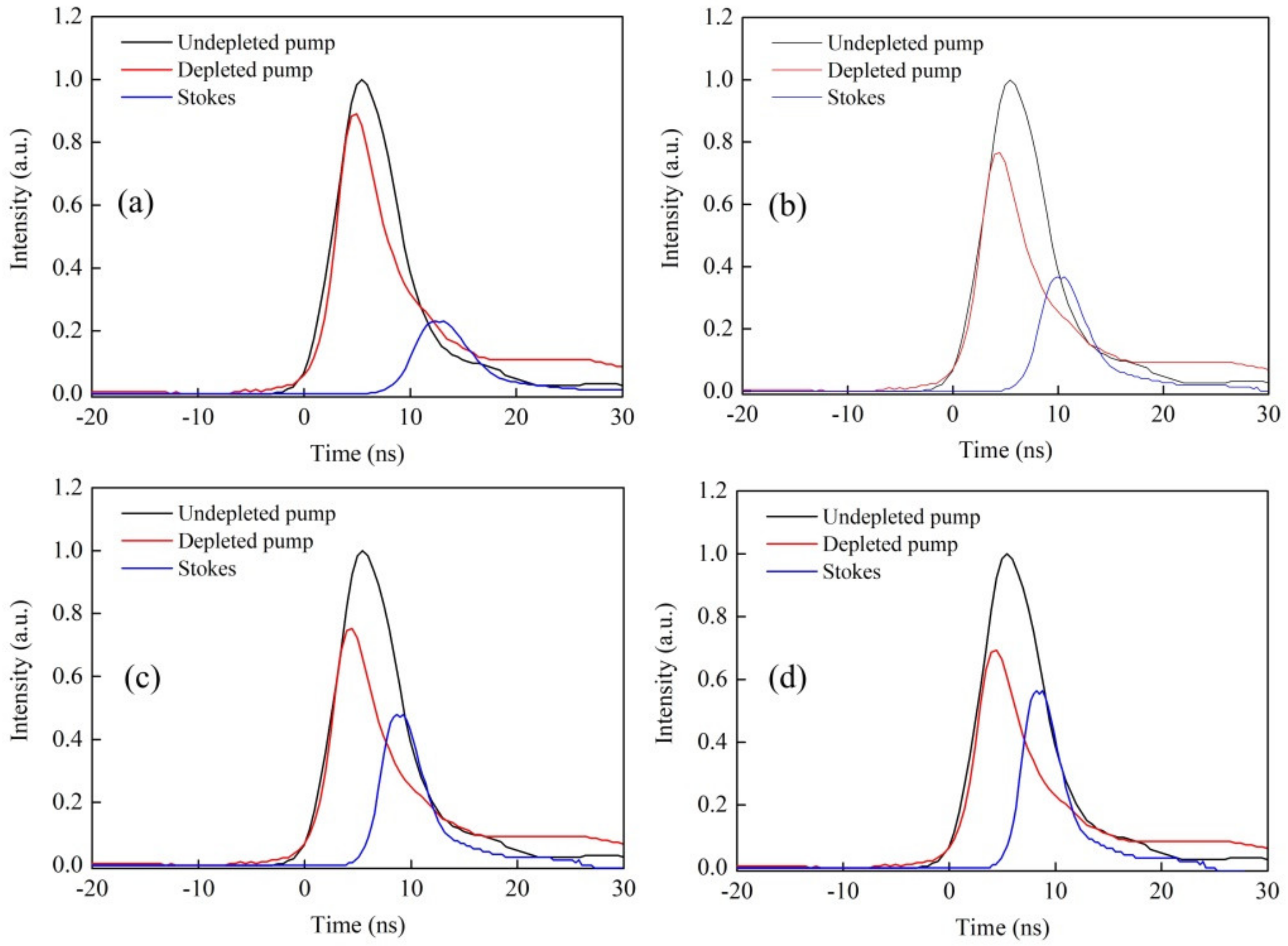1. Introduction
The application and development of terahertz (THz) technology are inseparable from the excellent terahertz radiation sources. Terahertz parametric sources are important terahertz sources and have many advantages such as high peak power, continuous tuning, good temporal and spatial coherence, room temperature operation, compactness, and ease of use [
1,
2,
3]. Their disadvantages are high pump threshold and low conversion efficiency.
The principle of terahertz parametric sources is the stimulated polariton scattering (SPS) in nonlinear crystals [
3,
4]. When a pump photon is consumed in the process of SPS, a Stokes photon and a polariton will be generated. The photon energies and the wave vectors obey the energy conservation and the momentum conservation. As the refractive index of the nonlinear crystal in the terahertz range is large, only non-collinear phase matching is available. The terahertz wave tuning can be obtained by adjusting the phase matching angle between the pump and Stokes beams [
5,
6].
Terahertz parametric sources include terahertz parametric generators (TPGs) and terahertz parametric oscillators (TPOs). A TPG consists of the pump laser source and the nonlinear crystal. If one seed laser is injected into the crystal at the corresponding phase matching angle, the TPG will become an injection-seeded TPG (I-S TPG), whose properties are greatly improved compared with the simple TPG [
7,
8,
9]. A TPO consists of the pump laser source, the nonlinear crystal, and the Stokes oscillating cavity. The cavity generates a high intensity Stokes beam and determines its propagating direction. The cavity can be a resonant cavity consisting of two mirrors in which the laser beam propagates back and forth along the same axis or a ring cavity having three or more mirrors in which the laser beam propagates in one way [
10,
11,
12,
13,
14,
15,
16]. A seed can be injected into the Stokes resonant cavity. K. Imai et al. reported an extracavity-pumped injection-seeded TPO in 2000. They achieved a narrow THz wave linewidth (<200 MHz) at a pump pulse energy of 55 mJ and a seeder power of 90 mW [
17]. In 2009, D. Walsh et al. reported an intracavity-pumped injection-seeded TPO. They achieved continuously tunable THz wave from 1 THz to 3 THz with the narrow linewidth (<100 MHz) [
18]. Both papers focused on the THz wave linewidths of the injection-seeded TPOs. So far, there have been no reports focusing on the improvement of the THz pulse energy based on the ring cavity injection-seeded TPO.
This paper presents an injection-seeded ring cavity TPO based on the MgO:LiNbO
3 crystal. The surface-emitted configuration was used for the THz wave output in this experiment [
19]. The ring cavity was constituted of three mirrors and the THz wave output surface where the pump and Stokes beams are totally reflected. The ring cavity for the injection-seeded TPO has the advantages of easier seed injection and higher pump energies. The experimental results show that the injection-seeded ring cavity TPO exhibits the benefits of lower pump thresholds and higher output energies for the Stokes and THz waves. The reasons for the laser performance improvement were analyzed.
2. Experimental Setup
The experimental setup of the injection-seeded ring-cavity TPO is shown in
Figure 1. The 1064.2 nm pump source was a multi-longitudinal mode Q-switched Nd:YAG laser with a repetition rate of 1 Hz and a pulse width of 7.5 ns. The pump beam diameter after the aperture was 3.5 mm. Two half wave plates (λ⁄2) (Thorlabs Inc., AHWP05M-980, Newton, NJ, USA) and one Brewster plate (BW) (Thorlabs Inc., BW1302, Newton, NJ, USA) were employed to adjust the pump pulse energy and to ensure that the pump laser polarization was parallel to the z-axis of the nonlinear crystal. The ring cavity was constituted by three mirrors M3, M4, and M5, and the THz wave output surface. M4 and M5 were coated for high reflection at the pump and Stokes wavelengths. The transmission of M3 at 1070.2 nm was 26.4%. The ring cavity length was about 45 cm.
The seed source was a continuous-wave fiber laser. It was pumped by a diode laser with the wavelength of 976 nm. The output wavelength was 1070.2 nm and the linewidth was 0.2 nm. The gain fiber was Yb3+ doped single mode fiber with a length of 0.5 m. The whole cavity length of the fiber laser was about 10.5 m after adding a common single mode fiber with a length of 10 m into the cavity. The cavity length of the Stokes laser was about 45 cm. The long cavity of the seed laser could make the longitudinal modes dense enough, so some of them could be matched with those of the Stokes laser. An isolator (Thorlabs Inc., IO-5-1064-VLP, Newton, NJ, USA) was used to prevent the returned light from damaging the seed laser, and half wave plates (λ⁄2) were used to adjust the polarization of the seed laser to be parallel to the z-axis of the nonlinear crystal. We used a telescope to enlarge the seed beam size to make it larger than the pump beam size (enlargement factor was 2.5). The reflectivities of M1 and M2 were higher than 99% and M2 was mounted on a rotating stage to enable the adjustment of the angle between the Stokes and pump waves. The angle between the injected seed and the output Stokes beam was about 45°, which ensures the safety of the seed laser.
A 5.0 mol% MgO doped LiNbO
3 crystal was used as the nonlinear crystal. The angle
β between the THz wave and Stokes wave in the MgO:LiNbO
3 crystal was calculated as about 65° [
19]. The shape of the MgO:LiNbO
3 crystal was designed as pentagonal, as shown in
Figure 2. The axis
y1 represents the propagation direction of the terahertz wave. Through this design, the pump and Stokes beams were incident perpendicularly into the crystal and totally reflected on the THz output surface. The generated THz wave could be emitted vertically through the output surface. The thickness of the MgO:LiNbO
3 crystal was 10.0 mm. The input and output surfaces of the crystal for the pump and Stokes beams were coated with anti-reflection film from 1060 nm to 1100 nm.
The pump and Stokes pulses energies were measured by an energy meter (Coherent Inc., J-50MB-YAG, Santa Clara, CA, USA). The THz signal was detected by a Golay cell (Tydex, GC-1D, Sanit Peterburg, Leningrad Region, Russia). A THz low pass filter (Tydex, LFP14.3-47, Sanit Peterburg, Leningrad Region, Russia) was used to isolate the near infrared wave.
3. Experimental Results of the Injection-Seeded TPO with the Ring-Cavity
The angle between the injected seed and the output Stokes wave was designed as approximately 45°. This means that the direction of the Stokes wave output from the cavity was different from that of the seed laser so that the output Stokes wave would not damage the seed laser. By using this ring cavity, the seed injection is convenient. Another advantage of the ring cavity for the injection-seeded TPO is that the nonlinear crystal can endure a stronger pump pulse. For the extra-cavity pumped scheme, the pump pulse propagates through the nonlinear crystal in one-way. Suppose that the pump pulse intensity is IP and the one-way propagating Stokes pulse intensity is IS. The total pulse intensity in the ring cavity is IP + IS. However, if a conventional Stokes resonator is used, the total pulse intensity in the resonator is IP + 2 IS for the same pump intensity.
In order to investigate the effect of the seed power on the TPO performance, three seed powers of 312.8 mW, 150.2 mW, and 47.5 mW (which were measured behind M3) were used in the experiment. The phase matching angle between the pump and Stokes beams outside the nonlinear crystal was about 1.5°, at which the generated Stokes wavelength was 1070.2 nm and the generated THz wave frequency was 1.58 THz. For comparison, the properties of the ring cavity TPO without seed injection were also measured.
Figure 3 and
Figure 4 show the THz pulse energies and Stokes pulse energies as functions of the pump pulse energy for different seed powers. The pump threshold was 34.8 mJ without seed injection. The pump thresholds decreased to 30.3 mJ, 26.7 mJ, and 25.2 mJ with seed powers of 47.5 mW, 150.2 mW, and 312.8 mW, respectively. It can be seen that the pump threshold was going to be saturated with increasing seed powder. Under certain pump energy, both the Stokes and THz pulse energies increased with increasing seed power. When the pump energy was 111.4 mJ, the maximum THz pulse energy was 1.01 μJ without seed injection. After injecting the seed for the power of 312.8 mW, the maximum THz pulse energy increased to 1.52 μJ. The corresponding Stokes energies were 12.2 mJ and 18.6 mJ, respectively.
The ratios of THz energies with seed injection to that without seed injection as functions of the pump pulse energy are shown in
Figure 5. When the pump energy was 34.8 mJ, the ratios for the seed powers of 312.8 mW, 150.7 mW, 47.5 mW were 6.1, 5.1, and 3.7, respectively. When the pump energy was 111.4 mJ, the ratios were 1.5, 1.4 and 1.2, respectively. The ratio can be considered as an indicator of the seed injection effect. It can be concluded that the smaller the pump pulse energy, the more obvious the effect of seed injection. As the seed power increased, the output THz pulse energy was increased, but the growth rate became slower. When the seed power was higher than 312.8 mW, the output energy did not increase significantly, so the maximum seed power was 312.8 mW in this experiment.
Keeping the pump power of 111.4 mJ, the spectrum of the Stokes wave without seed injection is shown in
Figure 6a, and
Figure 6b–d show the spectra of the Stokes waves for the seed powers of 47.5 mW, 150.7 mW, and 312.8 mW, respectively. After the seed injection, the linewidth of the Stokes wave reduced greatly. However, for different seed powers, the spectra of the Stokes waves had little change, and the linewidths kept nearly the same as that of the seed laser (about 0.2 nm). This means that after the seed injection, the spectrum of the Stokes wave is mainly determined by the seed laser.
4. Discussion
The process of SPS must obey the energy conservation (
ωP =
ωS +
ωT) and momentum conservation (
kP=
kS+
kT), where
ωP,
ωS, and
ωT are the frequencies of the pump, Stokes, and THz waves, respectively, and
kP,
kS, and
kT are the wave vectors of the three waves. By employing slowly varying envelope approximation, the coupled-wave equations of the THz wave in the
y direction of the nonlinear crystal can be expressed as [
20]
where
Ii(
i = p, s, T) are the intensities of the pump, Stokes, and THz waves, respectively, and
Ii are the functions of
x,
y,
z, and
t. The absorption coefficient
αT and the gain coefficient
g are given by
where
εT is the dielectric constant of the THz wave;
ni (
i = p, s, T) are the refractive indexes of the nonlinear crystal at the pump, Stokes, and THz wavelengths;
μ0 is the permeability of vacuum;
ε0 is the permittivity of vacuum;
ε∞ is the high-frequency dielectric constant;
c is the light speed in vacuum; and
d33 and
dQ are the nonlinear coefficients that denote the parametric process and Raman process, respectively.
According to Equation (1), the generated THz intensity is related to the product of IP and Is. A larger value of the product of IP and IS is profitable for the generation of the THz wave. However, the buildup of the Stokes pulse needs some time, which means that a temporal interval will exist between the pump and Stokes pulses. The seed injection results in a shorter buildup time for the Stokes pulse and a larger product of IP and IS, hence profitable for the THz wave generation. The larger the seed power, the smaller the buildup time will be for the Stokes pulse.
Figure 7 shows the waveforms of the original pump, depleted pump, and Stokes pulses for the pump energy of 111.4 mJ. The waveforms of the pump and Stokes pulses were recorded using two of the same Si detectors (Thorlabs Inc., DET10A/M, 200–1100 nm, rise time 1 ns, Newton, NJ, USA) that could show the temporal relation between the pump and stokes pulses. However, the real pulse intensity was not strictly proportional to the waveform height. The original pump pulse width was 6.9 ns.
Figure 7a shows the situation when the seed power was 0 mW (no seed). The pump pulse was obviously depleted, and the Stokes pulse was built up at which the pump pulse was depleted. The temporal interval between the pump and Stokes pulses was about 7.9 ns.
Figure 7b shows the situation when the seed power was 47.5 mW. The buildup time of the Stokes pulse was decreased to 6.5 ns. The depletion of the pump pulse was more serious, which means that more pump energy will be transformed into Stokes and THz energy.
Figure 7c,d shows the situations when the seed powers were 150.7 ns and 312.8 mW, respectively. The buildup times of the Stokes pulses were 5.9 ns and 5.6 ns, respectively. It can be seen that the seed injection leads to the decrease of the temporal interval between the pump and Stokes pulses. The higher the seed power injected, the more pump energy will be consumed to transform into the Stokes wave and THz wave.
5. Conclusions
The characteristics of the injection-seeded ring-cavity THz parametric oscillator were investigated. A 5.0 mol% MgO doped LiNbO3 crystal was used as the nonlinear crystal. The pump and seed wavelengths were 1064.2 nm and 1070.2 nm, respectively. The generated THz wave frequency was 1.58 THz. Compared with the ring cavity TPO without seed injection, the injection-seeded ring cavity TPO exhibited the benefits of lower pump thresholds and higher output energies for the Stokes and THz waves. The THz pulse energies and the Stokes pulse energies as functions of the pump pulse energy for different seed powers of 312.8 mW, 150.7 mW, 47.5 mW, and 0 mW (no seed) were investigated. The pump threshold was 34.8 mJ without seed injection. The pump thresholds decreased to 30.3 mJ, 26.7 mJ, and 25.2 mJ with seed powers of 47.5 mW, 150.2 mW, and 312.8 mW, respectively. When the pump energy was 111.4 mJ, the maximum THz wave pulse energy was 1.01 μJ without seed injection. After injecting the seed for the power of 312.8 mW, the maximum THz wave pulse energy increased to 1.52 μJ. We found that the smaller the pump pulse energy, the relatively larger effect the injected seed had. The reason for the performance improvement of the injection-seeded ring-cavity TPO was analyzed by using the coupled-wave equations and the temporal interval between the pump and Stokes pulses.
Author Contributions
Conceptualization, F.G. and X.Z.; Methodology, F.G. and Y.L.; Investigation, F.G.; Resources, Z.W. and N.M.; Writing—original draft preparation, F.G.; Writing—review and editing, Z.C., X.Z., and Z.L.; Visualization, X.C. and Z.Q. All authors have read and agreed to the published version of the manuscript.
Funding
This research was funded by the National Natural Science Foundation of China (grant numbers 61475087, 61775122) and the Key Technology Research and Development Program of Shandong (grant numbers 2019JMRH0111, 2017GGX10103).
Conflicts of Interest
The authors declare no conflict of interest.
References
- Wu, M.H.; Tsai, W.C.; Chiu, Y.C.; Huang, Y.C. Generation of ∼100 kW narrow-line far-infrared radiation from a KTP off-axis THz parametric oscillator. Optica 2019, 6, 723–730. [Google Scholar] [CrossRef]
- Kawase, K.; Sato, M.; Taniuchi, T.; Ito, H. Coherent tunable THz-wave generation from LiNbO3 with monolithic grating coupler. Appl. Phys. Lett. 1996, 68, 2483–2485. [Google Scholar] [CrossRef]
- Kawase, K.; Shikata, J.I.; Ito, H. Terahertz wave parametric source. Phys. D Appl. Phys. 2002, 35, R1–R14. [Google Scholar] [CrossRef]
- Johnson, B.C.; Puthoff, H.E.; Hoo, J.S.; Sussman, S.S. Power and linewidth of tunable stimulated farinfrared emission in LiNbO3. Appl. Phys. Lett. 1971, 18, 181–183. [Google Scholar] [CrossRef]
- Shikata, J.; Sato, M.; Taniuchi, T.; Ito, H.; Kawase, K. Enhancement of THz-wave output from LiNbO3 optical parametric oscillators by cryogenic cooling. Opt. Lett. 1999, 24, 202–204. [Google Scholar] [CrossRef] [PubMed]
- Lee, A.J.; Pask, H.M. Continuous wave, frequency-tunable terahertz laser radiation generated via stimulated polariton scattering. Opt. Lett. 2014, 39, 442–445. [Google Scholar] [CrossRef] [PubMed]
- Kawase, K.; Shikata, J.; Imai, K.; Ito, H. Transform limited, narrow-linewidth, terahertz-wave parametric generator. Appl. Phys. Lett. 2001, 78, 2819–2821. [Google Scholar] [CrossRef]
- Kawase, K.; Minamide, H.; Imai, K.; Shikata, J.; Ito, H. Injection-seeded terahertz-wave parametric generator with wide tenability. Appl. Phys. Lett. 2002, 80, 195–197. [Google Scholar] [CrossRef]
- Wu, M.H.; Chiu, Y.C.; Wang, T.D.; Zhao, G.; Zukauskas, A.; Laurell, F.; Huang, Y.C. Terahertz parametric generation and amplification from potassium titanyl phosphate in comparison with lithium niobate and lithium tantalite. Opt. Express 2016, 24, 25964–25973. [Google Scholar] [CrossRef] [PubMed]
- Zhang, R.L.; Qu, Y.C.; Zhao, W.J.; Liu, C.; Chen, Z.L. Si-prism-array coupled terahertz-wave parametric oscillator with pump light totally reflected at the terahertz-wave exit surface. Opt. Lett. 2016, 41, 4016–4019. [Google Scholar] [CrossRef] [PubMed]
- Wang, Y.Y.; Ren, Y.C.; Xu, D.G.; Tang, L.H.; He, Y.X.; Song, C.; Chen, L.Y.; Li, C.Z.; Yan, C.; Yao, J.Q. Energy scaling and extended tunability of a ring cavity terahertz parametric oscillator based on KTiOPO4 crystal. Chin. Phys. B 2018, 27, 114213. [Google Scholar] [CrossRef]
- Yan, C.; Wang, Y.Y.; Xu, D.G.; Xu, W.T.; Liu, P.X.; Yan, D.X.; Duan, P.; Zhong, K.; Shi, W.; Yao, J.Q. Green laser induced terahertz tuning range expanding in KTiOPO4 terahertz parametric oscillator. Appl. Phys. Lett. 2016, 108, 011107. [Google Scholar] [CrossRef]
- Edwards, T.J.; Walsh, D.; Spurr, M.B.; Rae, C.F.; Dunn, M.H.; Browne, P.G. Compact source of continuously and widely-tunable terahertz radiation. Opt. Express 2006, 14, 1582–1589. [Google Scholar] [CrossRef] [PubMed]
- Ortega, T.A.; Pask, H.M.; Spence, D.J.; Lee, A.J. THz polariton laser using an intracavity Mg:LiNbO3 crystal with protective teflon coating. Opt. Express 2017, 25, 3991–3999. [Google Scholar] [CrossRef] [PubMed]
- Minamide, H.; Ikari, T.; Ito, H. Frequency-agile terahertz-wave parametric oscillator in a ring-cavity configuration. Rev. Sci. Instrum. 2009, 80, 123104. [Google Scholar] [CrossRef] [PubMed]
- Yang, Z.; Wang, Y.; Xu, D.; Duan, P.; Yan, C.; Tang, L.; Yao, J. High-energy terahertz wave parametric oscillator with a surface-emitted ring-cavity configuration. Opt. Lett. 2016, 41, 2262–2265. [Google Scholar] [CrossRef] [PubMed]
- Imai, K.; Kawase, K.; Shikata, J.; Minamide, H.; Ito, H. Injection-seeded terahertz-wave parametric oscillator. Appl. Phys. Lett. 2001, 78, 1026–1028. [Google Scholar] [CrossRef]
- Walsh, D.; Stothard, D.; Edwards, T.; Browne, P.; Rae, C.; Dunn, M. Injection-seeded intracavity terahertz optical parametric oscillator. J. Opt. Soc. Am. B 2009, 26, 1196–1202. [Google Scholar] [CrossRef]
- Ikari, T.; Zhang, X.B.; Minamide, H.; Ito, H. THz-wave parametric oscillator with a surface-emitted configuration. Opt. Express 2006, 14, 1604–1610. [Google Scholar] [CrossRef] [PubMed]
- Wang, W.T.; Zhang, X.Y.; Wang, Q.P.; Cong, Z.H.; Chen, X.H.; Liu, Z.J.; Qin, Z.G.; Li, P.; Tang, G.Q.; Li, N.; et al. Multiple-beam output of a surface-emitted terahertz-wave parametric oscillator by using a slab MgO:LiNbO3 crystal. Opt. Lett. 2014, 39, 754–757. [Google Scholar] [CrossRef] [PubMed]
© 2020 by the authors. Licensee MDPI, Basel, Switzerland. This article is an open access article distributed under the terms and conditions of the Creative Commons Attribution (CC BY) license (http://creativecommons.org/licenses/by/4.0/).
